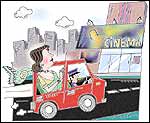|
 In
the first decade of real consumerism, the 1990s, the Indian consumer
was like a child, running amok amidst a playground full of noise,
colour, and choice, wanting everything in the shop window. Today,
the consumer is like an awkward teenager, in the process of making
the transition to a more restrained, more mature future, taking
a long, hard look at what lies outside the window. In
the first decade of real consumerism, the 1990s, the Indian consumer
was like a child, running amok amidst a playground full of noise,
colour, and choice, wanting everything in the shop window. Today,
the consumer is like an awkward teenager, in the process of making
the transition to a more restrained, more mature future, taking
a long, hard look at what lies outside the window.
All this while, marketers, and consumers have
defined their own and collective well-being in terms of direct consumption
of products, as in more tea/soap/washing powder consumed year-on-year,
and qualitatively, the upgrade to higher priced goods-never mind
that they all fulfill the same need. As consumers-and this will
be more true in urban areas-fathom and finally emerge from the orgy
of spending and profligate consumerism, consumption per se will
cease to be an end in itself. Consumers will start asking whether
the new markets and products have created a better quality of life.
There are already an embarrassment of nearly 20 shampoo brands:
how many more do you need, anyway? At some point, the consumer will
say, "enough already!" How much shampoo can you sell really
in a country where more than half the population does not have access
to proper bathroom facilities.
Clearly, a new variety of consumer needs will
emerge. Like clean cities. Parks. Playgrounds. Better roads. Consumers
will demand all this and civic authorities will provide these as
best as they can. And yes, it will cost more money, which will come,
from the consumer, who will increasingly not crib paying for utilities
that deliver a better quality of life.
Guaranteed 24-hour power supply, or your money
back! Bottled water-quality water on the tap! A healthcare, even
education system that delivers, for a just price. All this can't
be met by government alone. Private businesses have to step-in,
much like the Rs 73,000-crore healthcare opportunity that has already
roped in names like Reliance, Aditya Birla, Apollo, and Max.
Consumption trends will be driven primarily
by the young and the restless. Deeper media penetration, primarily
cable and satellite television, rising income levels and distribution-reach
in rural India, coupled with urbanisation, will blur the psychological
urban-rural divide. Expect to see the rural/urban consumer segmentation
near redundant for very many product categories.
Businesses, even government, will also increasingly
face an activist consumer, who is not just aware about her rights
but is willing to go that extra mile in getting it. Businesses and
governments will not just have to be more transparent but also empathise-or
seen to be empathising-with consumer needs.
The Indian consumer is finally putting the
subservience of the British rule behind her. She is finally more
honest of her own identity and needs. The dichotomy that many marketers
discovered at their peril-consumer opinions expressed are at variance
from the opinions they held-will gradually fade away. The Indian
consumer will be as real as you see. Or hear.
The Consumer Of The
Future
 URBAN
She is value-conscious, as ever, but also includes the brand
in her value metrics. She is willing to pay a premium for the intangible,
as long as the marketer can justify that it helps manage her life
better. She buys virtually everything through a debit or credit
card, largely at speciality retailers. She invests heavily on health/house/life
insurance premiums, and lives on hope built on the foundation of
a professional education, an individualistic but family-rooted outlook,
and a double-income household. She prefers to listen to her kind
of music on fm radio, from any one of three stations in its genre
within the city's 20-odd channels, while tuning to another for traffic
updates on her drive to work and back. At home it is either news
on the direct-to-home-enabled television or that sizzling sex-thriller
late at night. She gives in to the only child's demand for a holiday
abroad, even while factoring in the upgrade to the C-class car next
summer. URBAN
She is value-conscious, as ever, but also includes the brand
in her value metrics. She is willing to pay a premium for the intangible,
as long as the marketer can justify that it helps manage her life
better. She buys virtually everything through a debit or credit
card, largely at speciality retailers. She invests heavily on health/house/life
insurance premiums, and lives on hope built on the foundation of
a professional education, an individualistic but family-rooted outlook,
and a double-income household. She prefers to listen to her kind
of music on fm radio, from any one of three stations in its genre
within the city's 20-odd channels, while tuning to another for traffic
updates on her drive to work and back. At home it is either news
on the direct-to-home-enabled television or that sizzling sex-thriller
late at night. She gives in to the only child's demand for a holiday
abroad, even while factoring in the upgrade to the C-class car next
summer.
 RURAL
She now buys a 200-ml shampoo bottle, the one that was advertised
during last night's showing of Lagaan on Star. She still dances
when it rains, but the 24-hour paid electricity and a well-serviced
tube well means the fields are well-irrigated even when her Gods
play truant. Her two teenaged children go to a school in a nearby
town, not in a tractor any more but that multi-utility vehicle the
family bought two years ago. They return only late evening after
computer lessons. Though she still goes to the weekly haat to pick
up her vegetables and dry rations, what she looks forward, possibly
twice a year, is that 100 km drive to the big city to buy apparel,
audio cassettes of her favourite movies, and of course, that roller-coaster
ride at the amusement park. RURAL
She now buys a 200-ml shampoo bottle, the one that was advertised
during last night's showing of Lagaan on Star. She still dances
when it rains, but the 24-hour paid electricity and a well-serviced
tube well means the fields are well-irrigated even when her Gods
play truant. Her two teenaged children go to a school in a nearby
town, not in a tractor any more but that multi-utility vehicle the
family bought two years ago. They return only late evening after
computer lessons. Though she still goes to the weekly haat to pick
up her vegetables and dry rations, what she looks forward, possibly
twice a year, is that 100 km drive to the big city to buy apparel,
audio cassettes of her favourite movies, and of course, that roller-coaster
ride at the amusement park.
-Shailesh Dobhal
|

